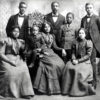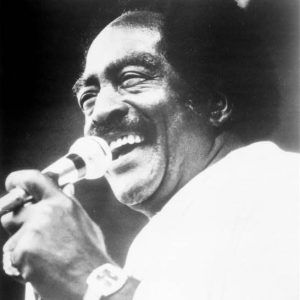calsfoundation@cals.org
Jimmy "Spoon" Witherspoon (1921?–1997)
James John (Jimmy) Witherspoon, also known by the nickname “Spoon,” was a versatile singer who achieved commercial success and critical acclaim in the genres of blues, jazz, and rhythm and blues. His 1947 recording “Ain’t Nobody’s Business” was a hit in 1949 and became his signature song.
Jimmy Witherspoon was born in Gurdon (Clark County) to Leonard Witherspoon, a Missouri Pacific Railroad brakeman, and Eva Tatum Witherspoon, a church pianist. The family was devoutly religious. His parents were members of the choir at their Baptist church. His date of birth is usually given as August 8, 1923, but some sources give the birth year as 1920, and more than one source gives the birth date as August 18, 1921, attributing the information to his son. Since he may have run away from home to Los Angeles, California, as early as 1935, the earlier dates seem more plausible. In a 1996 interview, he gave his age as seventy-four, which also corresponds with the 1921 date.
His parents’ religiosity, especially his mother’s—his father died during his early childhood—was influential throughout his life. His mother strenuously objected to blues music, which she considered “dirty” and unsophisticated. Notwithstanding, at an early age Witherspoon listened to blues and other secular music locally on jukeboxes and the radio. Witherspoon’s ambition to become a professional singer developed early in life, as did his talent. He joined the church choir at about age five and won a Clark County singing contest during the same time.
After arriving in Los Angeles in the mid-1930s, he worked as a dishwasher at a drugstore and patronized the blues and jazz clubs located in Los Angeles’s Central Avenue District during his off hours. In these clubs, he met some of the leading West Coast blues and jazz performers, including his idol, blues singer Big Joe Turner. He also began sitting in with some of the local bands, quickly becoming an audience favorite.
In 1941, Witherspoon joined the U.S. Merchant Marines and served aboard ships transporting supplies to British forces in Asia. On shore leave in Calcutta, India, he sang with a big band led by American jazz pianist Teddy Weatherford, a performance broadcast by the U.S. Armed Forces Radio Service, a service the Department of War had created in 1942 to entertain and inform military personnel deployed overseas.
After being discharged from the Merchant Marines in 1943, Witherspoon returned to California and soon joined renowned blues and jazz pianist Jay McShann’s band. He was McShann’s lead singer from 1944 until 1948. In 1949, the recording of their re-worked version of Bessie Smith’s “Ain’t Nobody’s Business” reached the top of Billboard magazine’s R&B chart. It stayed on the chart for an unprecedented run of thirty-four weeks.
Witherspoon’s other hits with McShann, and as a solo artist, did not attain the extraordinary success of “Ain’t Nobody’s Business.” His career soon began to founder, accelerated by the emergence of rock and roll music, resulting in serious financial and personal setbacks. In 1953, he declared bankruptcy and divorced his first wife, Rachel, whom he had married in 1951. (They had no children.) Witherspoon struggled through lean years in the 1950s, recorded for small labels, and staged a comeback at the 1959 Monterey Jazz Festival, headlining with the Count Basie Orchestra, Woody Herman, Sarah Vaughan, and others. Witherspoon’s performance at the festival established his reputation as a formidable jazz singer; it also was the first time his mother attended one of his concerts.
From the early 1960s into the mid-1990s, Witherspoon performed regularly at concerts in the United States and abroad, maintained a sporadically successful solo recording career, and collaborated with dozens of artists, including admirers from the rock and roll world such as Dr. John, Eric Burdon, and Van Morrison. He also began acting occasionally, appearing in a few television shows and in the films The Black Godfather (1974), To Sleep with Anger (1990), and Georgia (1995).
Witherspoon’s marital history is complicated. He reportedly reconciled briefly with his first wife in 1958. In mid-1962, however, he married Diana Williams, but by the end of the year he was reported to have initiated divorce proceedings. In the early 1970s, he was with a woman named Joyce. However, a 1978 news item announced his engagement to Sharon Rivera and reported that he had been a bachelor for twelve years. Finally, his 1997 obituary identifies his surviving spouse as Diana.
Witherspoon was diagnosed with throat cancer in the 1980s and survived, but the treatments damaged his vocal chords and harmed his singing voice. Rehabilitation enabled him to resume his career, albeit with a raspy vocal quality that was somewhat diminished from the resonant baritone of his glory years. The cancer returned in the 1990s, but he continued performing until shortly before his death in Los Angeles on September 18, 1997. He was survived by his wife, three children, and four grandchildren. His obituary listed two surviving siblings.
Witherspoon earned numerous accolades during his career, including inductions into several music halls of fame, most notably the Ebony magazine Blues Hall of Fame in 1976, Arkansas Jazz Heritage Foundation’s Arkansas Jazz Hall of Fame and Arthur L. Porter Lifetime Achievement Award in 1996, the Blues Foundation’s Blues Hall of Fame in 2008, and Grammy Award nominations in 1984, 1987, and 1996. He also was a recipient of the prestigious National Association for the Advancement of Colored People (NAACP) Image Award in 1975. His prolific recording output includes Jimmy Witherspoon at the Monterey Jazz Festival (1959), Midnight Lady Called the Blues (1986), and Live at the Mint (1996).
For additional information:
Clark, Donald, ed. The Penguin Encyclopedia of Popular Music. New York: Penguin Books, 1989.
Deffaa, Chip. Blue Rhythms: Six Lives in Rhythm and Blues. Urbana: University of Illinois Press, 1996.
Ratliff, Ben. “Jimmy Witherspoon, Singer of Blues and Jazz, Dies at 74.” New York Times, September 22, 1997. Online at http://www.nytimes.com/1997/09/22/arts/jimmy-witherspoon-singer-of-blues-and-jazz-dies-at-74.html (accessed February 8, 2022).
Rowe, Monk. Interview with Jimmy Witherspoon, April 12, 1996. Hamilton College Jazz Archives. Hamilton College, Clinton, New York.
Greg A. Phelps
Lindsey Wilson College
 African Americans
African Americans Jimmy "Spoon" Witherspoon
Jimmy "Spoon" Witherspoon 




Hey cousin! Uncle Jimmy was my favorite uncle. I was afraid of his dogs because they dragged me into the bushes at his house on the hill and tried to kill me. I have a lot of pictures of him.
I wanted to clear up a few facts about my dad’s marriages. First, my mother, Diana Witherspoon Atkins, was his ONLY legal spouse. My mom and dad were very close until the time of his death. He never removed her from any documents as spouse. As a matter of fact, when he passed away, she was the first person contacted. That’s probably why she is listed as spouse after his death. Joyce Witherspoon was with my father for many, many years, and she was wonderful. They were not married, but she is and always will be my stepmother.
As for his birth date, my Grandma Eva gave his birth date to me as August 18, 1923. I absolutely know the month and day are correct!